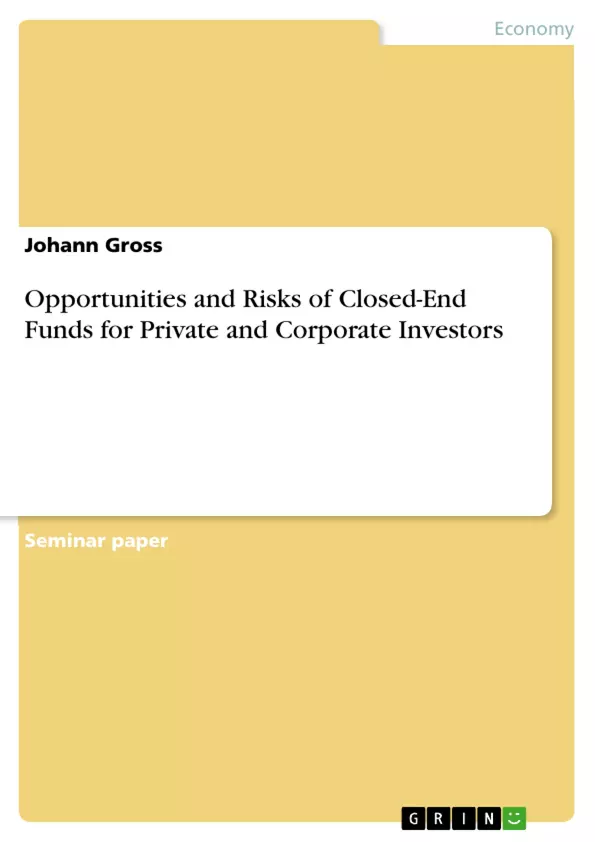Capital markets provide many investment opportunities, but CEFs offer the possibility of high returns and attractive alternative investments. The fund subjects can vary and so many categories have been established during the last decades. Today, investments in real estates, ships, renewable energy, planes, and other divisions are open for private and corporate investors. The main challenge for the investor is to understand the product, which is essential for an investment decision. The conception and operative stage of a fund is complex and sophisticated why many investors keep distance to these type of investments. The previous market development has shown that there are many risks and opportunities given which have to be considered. An evaluation of these aspects is cru-cial to the investment success and should be clearly observed. The legislator has stan-dardized the information system of CEFs to offer the possibility of well-arranged in-formation which is intelligible to all. Summing up, an investor has to identify the main risks and opportunities of a CEF investment and then to evaluate the possible return consistent with his portfolio strategy.
Inhaltsverzeichnis (Table of Contents)
- Abstract
- Table of Contents
- List of Abbreviations
- List of Tables
- List of Figures
- Introduction
- Problem Definition
- Objectives
- Methodology
- Theoretical Part
- Definition
- Conception Design of Closed-End Funds
- Holding Structure
- Specific Types of Closed-End Funds
- Current Development of the Closed-End Fund Market in Germany
- Risks of Closed-End Funds
- Opportunities of Closed-End Funds
- Business Case: Analysis of the WealthCap Immobilien Deutschland 35 "Ten Towers München" Fund
- Conclusion
- Bibliography
- Online Sources
Zielsetzung und Themenschwerpunkte (Objectives and Key Themes)
This study investigates the opportunities and risks of closed-end funds (CEFs) for both private and corporate investors. It aims to provide a comprehensive understanding of the product, its structure, and the current market developments in Germany. This analysis will explore the complexities of CEF investments and highlight the critical considerations for potential investors.
- Understanding the conception and operative design of closed-end funds
- Evaluating the risks associated with closed-end fund investments
- Exploring the potential opportunities and benefits of closed-end funds
- Analyzing the current market dynamics and development of closed-end funds in Germany
- Providing insights into the information systems and regulations governing closed-end funds
Zusammenfassung der Kapitel (Chapter Summaries)
- Introduction: This chapter introduces the study's objectives, research methodology, and the significance of closed-end funds in the investment landscape.
- Theoretical Part: This section delves into the definition and design of closed-end funds, including their holding structures and various types. It also examines the current market trends and regulations impacting closed-end funds in Germany.
- Risks of Closed-End Funds: This chapter explores the inherent risks associated with closed-end fund investments, highlighting factors such as market volatility, illiquidity, and potential conflicts of interest.
- Opportunities of Closed-End Funds: This chapter examines the potential benefits of closed-end fund investments, including access to alternative asset classes, diversification potential, and potential for high returns.
- Business Case: Analysis of the WealthCap Immobilien Deutschland 35 "Ten Towers München" Fund: This chapter provides a practical case study, analyzing a specific closed-end fund and its investment strategy, highlighting key considerations and challenges.
Schlüsselwörter (Keywords)
Closed-end funds, private investors, corporate investors, investment opportunities, risks, opportunities, market development, Germany, regulations, investment strategy, diversification, alternative investments, real estate, renewable energy, illiquidity, risk management, portfolio management, financial markets.
- Citation du texte
- Johann Gross (Auteur), 2013, Opportunities and Risks of Closed-End Funds for Private and Corporate Investors, Munich, GRIN Verlag, https://www.grin.com/document/280937



